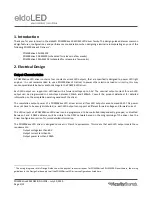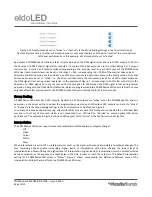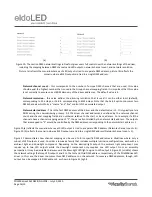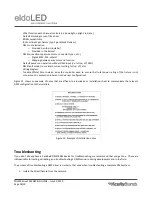
POWERdrive 50W DESIGN GUIDE
–
July 30, 2020
Page 8/19
It is, in general, best to keep the remote mounting distance as short as possible. Depending on the site and application
requirements in terms of EMI/RFI emissions and susceptibility, one may consider running remote wiring in conduit or
using shielded cables. It is the responsibility of the fixture OEM to validate the design and performance of the fixture
system in the application, including remote-mounted LED driver solutions.
Creating DMX IN and DMX OUT connections for the luminaire
Each POWERdrive LED driver represents one
“
unit load
”
on the DMX bus. The DMX standard allows up to 32
“
unit loads
”
on each bus. If additional drivers are needed on the bus, then a repeater or signal booster is necessary.
DMX utilizes daisy-chain connections between devices on a DMX network. To ensure trouble-free operation, close
attention must be paid to the DMX wiring within a luminaire as well as in the DMX network itself. To facilitate daisy-
chaining of multiple DMX luminaires in a DMX network, each DMX luminaire should provide separate DMX IN and DMX
OUT connections, each containing DMX +, DMX - and DMX SHIELD conductors (all three are required for proper
operation). This can, for example, be accomplished as shown in Figure 5 and . A
“T
-
tap”
connection to the DMX terminals
of the POWERdrive LED driver within the luminaire should be made as short as possible, preferably less than 2 -3 inches.
Care must be taken when preparing the DMX cable; the shield/drain wire should not make any contact to any part of the
fixture other than the DMX shield input terminal on the driver. Accidental contact with the fixture body (earth ground)
may result in interference with the DMX signal.
Table 2: Maximum allowable cable distance (in ft) as function of the wire gauge and drive current that keeps the
voltage drop in the cable below 1V.





































